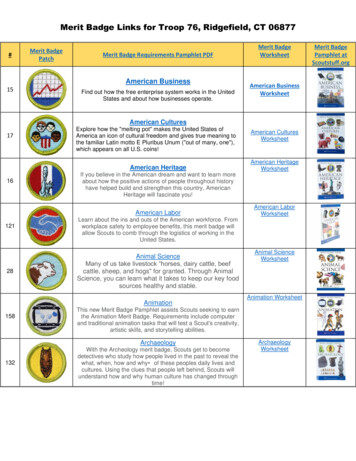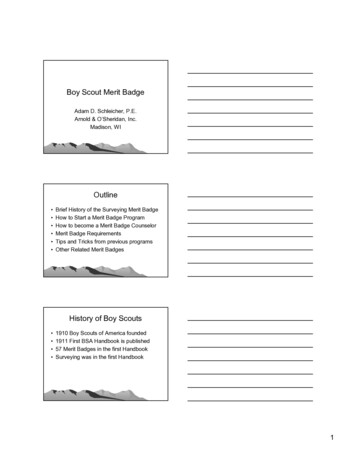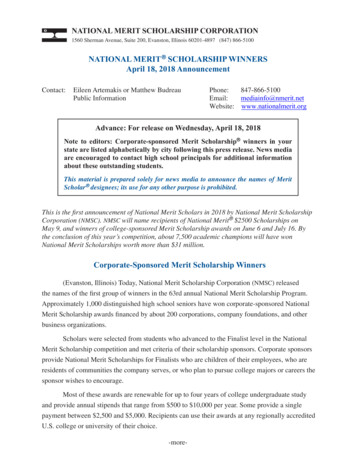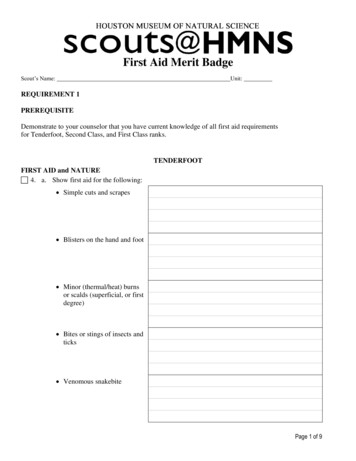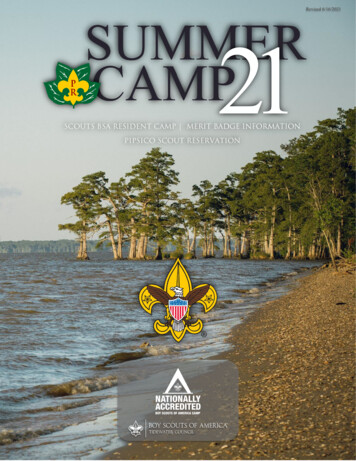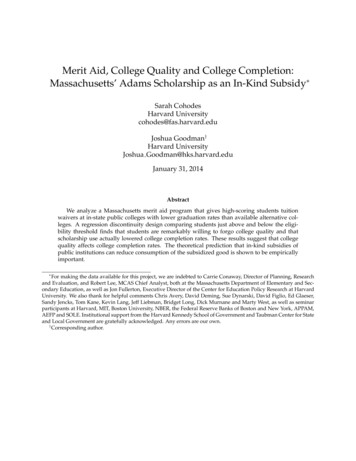
Transcription
Merit Aid, College Quality and College Completion:Massachusetts’ Adams Scholarship as an In-Kind Subsidy Sarah CohodesHarvard Universitycohodes@fas.harvard.eduJoshua Goodman†Harvard UniversityJoshua Goodman@hks.harvard.eduJanuary 31, 2014AbstractWe analyze a Massachusetts merit aid program that gives high-scoring students tuitionwaivers at in-state public colleges with lower graduation rates than available alternative colleges. A regression discontinuity design comparing students just above and below the eligibility threshold finds that students are remarkably willing to forgo college quality and thatscholarship use actually lowered college completion rates. These results suggest that collegequality affects college completion rates. The theoretical prediction that in-kind subsidies ofpublic institutions can reduce consumption of the subsidized good is shown to be empiricallyimportant. For making the data available for this project, we are indebted to Carrie Conaway, Director of Planning, Researchand Evaluation, and Robert Lee, MCAS Chief Analyst, both at the Massachusetts Department of Elementary and Secondary Education, as well as Jon Fullerton, Executive Director of the Center for Education Policy Research at HarvardUniversity. We also thank for helpful comments Chris Avery, David Deming, Sue Dynarski, David Figlio, Ed Glaeser,Sandy Jencks, Tom Kane, Kevin Lang, Jeff Liebman, Bridget Long, Dick Murnane and Marty West, as well as seminarparticipants at Harvard, MIT, Boston University, NBER, the Federal Reserve Banks of Boston and New York, APPAM,AEFP and SOLE. Institutional support from the Harvard Kennedy School of Government and Taubman Center for Stateand Local Government are gratefully acknowledged. Any errors are our own.†Corresponding author.
1IntroductionRecent research has emphasized troubling trends in U.S. college completion rates over the past fewdecades. Among students entering college, completion rates are lower today than they were in the1970s, due largely to low completion rates of men and students from lower socioeconomic backgrounds (Belley and Lochner 2007, Bailey and Dynarski 2011). This trend has spurred a vigorousdebate over the relative importance of factors that vary across students, such as academic skill andfamily financial resources, and factors that vary across postsecondary institutions, such as fundinglevels or management quality. Distinguishing the influence of student-level and institution-levelfactors on college completion rates is confounded by the non-random selection of students intoinstitutions of different apparent quality. In this paper, we provide further evidence consistentwith the fact that the quality of the institutions themselves affects college completion rates.To do so, we exploit is a Massachusetts merit aid program in which high school students withtest scores above multiple thresholds were granted tuition waivers at in-state public colleges. Suchcolleges were of lower quality than the average alternative available to such students, where quality is measured by a combination of graduation rates, academic skill of the student body, andinstructional expenditures, as suggested by Black and Smith (2006). The scholarship, though relatively small in monetary value, induced substantial changes in college choice, allowing us toestimate the impact of college quality on students’ postsecondary enrollment decisions and ratesof degree completion. A regression discontinuity design comparing students just above and below the eligibility threshold finds that students are remarkably willing to forgo college quality forrelatively little money and that marginal students lowered their college completion rates by usingthe scholarship. College completion rates decreased only for those subsets of students forgoingthe opportunity to attend higher quality colleges when accepting the scholarship. We describethe magnitude of this response as remarkable because the value of the scholarship is dwarfed byestimates of the forgone earnings of attending a lower quality college or failing to graduate. Asa whole, these results suggest that college quality has a substantial impact on college completion rates. We also find clear evidence that this scholarship increased college enrollment, thoughnot graduation, rates for the most disadvantaged students. Such students comprise, however, an1
extremely small fraction of the total pool of those eligible for this merit aid.Our research contributes to three strands in the literature on postsecondary education and thepublic subsidy of such education. First, a now extensive literature documents the sensitivity ofstudents’ college enrollment decisions to financial aid generally (Deming and Dynarski 2010, Kane2006) and merit aid more specifically (Dynarski 2000, Cornwell et al. 2009, Dynarski 2008, Kane2007, Pallais 2009, Goodman 20081 ). In contrast to most of the programs studied in this literature,the Adams Scholarship targets a very highly skilled set of students, namely the top 25% of highschool graduates in each school district. As a result, our estimates are generated by a part of theskill distribution not often studied. Furthermore, unlike in most aid programs, recipients wereautomatically notified of their eligibility without having to apply. Simplifying the aid process isknown to affect students’ college enrollment decisions (Bettinger et al. 2012), so that this programdesign may explain in part the large impacts of aid observed here. Our results are also consistentwith Fitzpatrick and Jones (2012), which finds that merit aid does effectively keep some studentsin state but that marginal students are a small fraction of total aid recipients.Second, we add to the growing literature on the impact of college quality on student outcomes.Much of the literature on the impact of college quality on degree completion has focused on thecommunity college sector, reaching varying conclusions about whether access to and quality ofcommunity colleges affects educational attainment (Rouse 1995, Leigh and Gill 2003, Sandy et al.2006, Calcagno et al. 2008, Stange 2009, Reynolds 2012). Estimates of the impact of college quality on labor market earnings are similarly varied, with some positive (Loury and Garman 1995,Brewer et al. 1999, Chevalier and Conlon 2003, Black and Smith 2004, Black and Smith 2006, Long2008, Hoekstra 2009, Andrews et al. 2012), some zero or positive only for disadvantaged subgroups (Dale and Krueger 2002, Dale and Krueger 2011), and some suggesting that earnings differences dissipate once the job market properly understands graduates’ underlying ability (Brand1This paper represents an extension and improvement of Goodman (2008), which studied the same merit aid program at an earlier time and used less informative outcome data. In particular, that earlier paper could only measurewhether graduating high school seniors self-reported their intention to enroll in public or private colleges, withoutidentification of specific campuses, actual enrollment or persistence and graduation. This paper, in contrast, uses substantially more detailed administrative data that allows identification of the specific institutions students actually enrollin, as well measurement of persistence and graduation rates. This allows for clear estimation of the quality and costtradeoffs students are making, the impact of this merit aid on in-state enrollment and, perhaps most importantly, theimpact of this aid on college graduation rates.2
and Halaby 2006, Lang and Siniver 2011). Nearly all of these research designs attempt to eliminateselection bias either by conditioning on students’ observable characteristics or by instrumentingcollege quality with distance from or tuition of nearby colleges. Neither approach entirely eliminates the possibility that unobserved student-level factors may be driving their estimates. Theexception to this is Hoekstra (2009), which uses a discontinuity inherent in the admissions processto a flagship university to estimate the labor market return to an elite college education. We employ a similarly identification strategy and unlike Hoekstra are able to observe the college choicemade by students not enrolling in the target institutions, allowing us to estimate the impact ofmerit aid on college quality. Though sources of exogenous variation in school and curriculumquality are more common at lower levels of schooling because of school choice lotteries (Deming et al. 2011) and test score-based admissions rules (Bui et al. 2011, Abdulkadiroglu et al. 2011,Dobbie and Fryer 2011), they are rarer in the postsecondary literature.Furthermore, our finding that college quality plays an important role in completion rates isconsistent with important pieces of recent evidence. Controlling for rich sets of student characteristics does not eliminate wide variation among postsecondary institutions in completion rates(Bowen et al. 2009). Students who attend college in large cohorts within states have relativelylow college completion rates, likely stemming from decreased resources per student given states’tendencies to change public postsecondary budgets slowly (Bound and Turner 2007). Bound et al.(2010) argue that the vast majority of the decline in completion rates can be statistically explainedby decreasing resources per student within institutions over time and, even more importantly,shifts in enrollment toward the relatively poorly funded public sector. All of this suggests thatcharacteristics of colleges themselves, such as resources available per student, play an importantrole in completion rates and that student-level factors are only part of the story.Third, we show the empirical importance of the theoretical possibility first discussed in Peltzman (1973) that in-kind subsidies of public institutions can reduce consumption of the subsidizedgood. Prior work has shown how public in-kind subsidies can generate at least partial crowdout of privately provided health insurance (Cutler and Gruber 1996, Brown and Finkelstein 2008),preschools (Bassok et al. 2012) and two-year colleges (Cellini 2009). Peltzman’s contribution was3
the prediction that, in some cases, crowdout could theoretically be large enough to reduce overall consumption of the subsidized good. Work by Ganderton (1992), using cross-state variationin tuition subsidies, and Long (2004), using much finer college-specific variation in such subsidies, suggests that this in-kind public support for postsecondary education does reduce overallspending on education. We contribute to this literature by providing the first evidence of suchreduced consumption driven by an exogenous shock in the size of the in-kind subsidy. We alsoshow that this reduced spending on higher education comes at the cost of a reduced probabilityof degree completion, a possibility recognized by Kane (2007) in his evaluation of the D.C. Tuition Assistance Grant program but unexplored because too little time had passed to look beyondenrollment effects.The structure of the paper is as follows. In section 2, we describe the merit scholarship program in detail. In section 3, we describe the data on students and colleges, including our measuresof college quality. In section 4, we explain our empirical strategy, a regression discontinuity design that accounts for the multiple thresholds students must cross in order to be eligible for aid.In section 5, we present estimates of the impact of college quality on enrollment decisions andcompletion rates. In section 6, we discuss implications of our findings and conclude in section 7.2The Adams ScholarshipAll Massachusetts public high school 10th graders take the Massachusetts Comprehensive Assessment System (MCAS), which includes an English language arts (ELA) portion and a mathematicsportion. Scores on each portion range in multiples of two from 200 to 280, with 260-280 categorized as “advanced” and 240-258 as “proficient”. In January 2004, Massachusetts Governor MittRomney proposed the John and Abigail Adams Scholarship Program, which would waive tuitionat in-state public colleges for any student whose total MCAS score placed him or her in the top25% of students statewide.2 Romney’s two stated goals seemed to be keeping highly talented2The eponymous couple cared deeply about education. John Adams wrote, in the Massachusetts Constitution,that “Wisdom, and knowledge, as well as virtue. as these depend on spreading the opportunities and advantagesof education in the various parts of the country, and among the different orders of the people, it shall be the duty oflegislatures and magistrates, in all future periods of this commonwealth, to cherish the interests of literature and thesciences, and all seminaries of them; especially the university at Cambridge, public schools and grammar schools in4
students in state and improving the quality of the state’s public postsecondary institutions. Inhis January 15, 2004 State of the Commonwealth speech to the Massachusetts legislature, Governor Romney explained that “I want our best and brightest to stay right here in Massachusetts.”3Conversations with individuals involved with the scholarship’s inception also suggest that Massachusetts wanted the recently introduced MCAS exam to be seen as a valid measure of studentachievement and was thus willing to, in effect, put its money where its mouth was.Concerned that Governor Romney’s statewide standard would assign scholarships largely tostudents in wealthy, high-performing school districts, the state Board of Higher Education ultimately approved a modified version of the program in October 2004.4 Under the approved policy,which has continued through at least 2013, a student receives a tuition waiver if his or her MCASscores fulfill three criteria. First, he or she must score advanced on one portion of the exam. Second, he or she must score proficient or advanced on the other portion of the exam. Third, thestudent’s total MCAS score must fall in the top 25% of scores in his or her school district.5 Thescores used to determine eligibility come from each student’s first attempt at taking the grade 10MCAS tests in ELA and mathematics. To receive the scholarship, a student must be enrolled inand graduate from a Massachusetts public high school in his or her senior year. The graduatingclass of 2005 was the first to receive Adams scholarships.Scholarship winners are automatically notified by letter in the fall of their senior year. Thescholarship waives tuition at any of four University of Massachusetts (U. Mass.) campuses, nine(four-year) state colleges, or fifteen (two-year) community colleges.6 As such, the letter that Governor Romney sent to the first class of scholarship recipients promised in bold-faced and underlinedletters “four years of free tuition.” Receipt of the scholarship does not, however, eliminate the costthe towns” (Chapter V, Section II). Abigail Adams, disturbed by the 18th century gender gap, wrote that “It is reallymortifying, sir, when a woman possessed of a common share of understanding considers the difference of educationbetween the male and female sex, even in those families where education is attended to” (Letter to John Thaxter,February 15, 1778).3See the January 20, 2004 Boston Globe article, “Specialists Blast Romney Proposal for Free Tuition,” by Jenna Russell.4See the October 20, 2004 Boston Globe article, “New MCAS Scholarship OK’d,” by Jenna Russell.5As of the class of 2006, students in charter schools or who participate in school choice or the Metco program canfulfill the third criterion by placing in the top 25% of the district they attend or the district in which they reside.6Six of Massachusetts’ state colleges (Salem, Bridgewater, Fitchburg, Framingham, Westfield and Worcester) wererenamed “state universities” in 2010. For simplicity, we refer to them as “state colleges” throughout the paper.5
of college attendance. To clarify the distinction between tuition and fees, the letter to the secondclass of scholarship recipients added to its final paragraph the disclaimer that “College fees androoming costs are not included in this scholarship award.” More recent letters have emphasizedthis fact even more clearly.7Figure A.4 shows the tuition and mandatory fees at the University of Massachusetts at Amherstand Bridgewater State College, the two largest campuses in their respective sectors. Strikingly, atboth campuses and nearly all other public Massachusetts colleges, tuition has remained constantin nominal terms over the past decade. Mandatory fees have, however, risen dramatically.8 For thefirst class of scholarship winners in 2005, the tuition waiver was worth 1,714 annually if used atU. Mass. Amherst or 910 if used at Bridgewater State. Given mandatory fees of 7,566 at U. Mass.Amherst and 4,596 at Bridgewater State, the Adams Scholarship thus represented a roughly 20%reduction in the direct cost of attendance. By the fall of 2011, fees had risen by more than a third,so that the Adams Scholarship represented a less than 15% reduction in the cost of attendance.These percentages would be substantially lower if room, board and other expenses were includedin the total cost of attendance. Conversations with individual colleges’ financial aid offices alsosuggest that for some students this aid is factored into financial aid offers and may be partiallycrowded out as a result.9 The Adams Scholarship thus lowers the cost of college attendance bywell under 20%, may be partially crowded out by college financial aid offices, is worth at most 6,856 (4* 1,714) over four years, and is substantially less valuable than other well-known meritaid scholarships such as the Georgia HOPE and CalGrant awards (Dynarski 2008, Kane 2007). Byall of these measures, the Adams Scholarship represents a relatively small amount of financial aid.7See Figures A.1, A.2 and A.3 for copies of these letters.This peculiar detail may be due to the fact that tuitions are set by the Massachusetts Board of Higher Educationand flow directly to the state’s General Fund, while fees are set by each college’s Board of Trustees and are retained bythe colleges themselves.9We spoke to financial aid officers at all of the U. Mass. campuses about their current policies, which they all believedhave been in place since the inception of the Adams Scholarship. All four ask students to send their notification lettersas soon as possible in the admissions process, as the financial aid offices do not have their own list of winners. U. Mass.Amherst said there was little scope for crowdout because most students send their letters after receiving financial aidoffers, though students who send the letters early may be offered grant money in place of a tuition waiver. U. Mass.Lowell said that scholarship status was used in determining financial aid offers and that late notification of scholarshipeligibility results in a recalculation of the aid offer. U. Mass. Boston and Dartmouth also said that scholarship statuswas used in determining financial aid offers but claimed that scholarship winners who would otherwise have qualifiedfor tuition waivers would instead receive other funding.86
Finally, those eligible for the scholarship can use it for a maximum of eight fall and springsemesters only if they graduate from a Massachusetts public high school, are accepted at a Massachusetts public college or university, and enroll at that institution full-time by the fall followingtheir high school graduation.10 The student must also complete the Free Application for FederalStudent Aid (FAFSA) and send the Adams Scholarship award letter to the financial aid or bursarsoffice at the institution he or she plans to attend.11 To continue receiving the Adams Scholarship,a student must continue his or her full-time enrollment at a Massachusetts public college or university, must maintain a cumulative college GPA of at least 3.0, and must complete the FAFSAannually.3Data, Descriptive Statistics and College Quality3.1Data and Descriptive StatisticsThe Massachusetts Department of Elementary and Secondary Education (DESE) provided thedata, which include demographic information, test scores, and Adams Scholarship status for allMassachusetts public high school students expected to graduate from high school from 2004-2011.We use first time 10th grade MCAS test scores. In both math and ELA, we observe scaled scoresthat determine scholarship eligibility, as well as the raw scores on which those scaled scores arebased. We use two main analysis samples, high school graduates from the classes of 2005-06, forwhom we observe six-year college graduation rates, and high school graduates from the classesof 2005-08, for whom we observe four-year college graduation rates.12College outcomes come from DESE’s merge of its data on high school graduates with theNational Student Clearinghouse (NSC) database, which covers 94% of undergraduates in Mas10The most recent cohorts are allowed to use the scholarship within six years of graduating high school, but suchcohorts are not included in our analysis.11Scholarship users must also be a U.S. citizen or permanent resident of the U.S. and must have been a permanentlegal resident of Massachusetts for at least one year prior to entering college as a freshman.12We limit the sample to high school graduates, as only graduates were ultimately eligible for the Adams scholarship.Of those who receive the Adams scholarship letter in the fall of 12th grade, over 98% ultimately graduate from highschool. We find no evidence that receipt of this letter affected high school graduation rates, so this restriction does notcreate selection bias.7
sachusetts.13 We observe for each high school graduate every detailed college enrollment spellthrough 2012 and graduation if it occurs.14 We add to this additional characteristics such as collegecosts and quality measures from the U.S. Department of Education’s Integrated Postsecondary Education Data System (IPEDS) and the 2009 Barron’s rankings of colleges. We separate colleges intoAdams eligible institutions (U. Mass. campuses, state colleges and community colleges) and otherinstitutions, such as in-state private or out-of-state colleges.Table 1 shows the mean characteristics of the two analysis samples. Columns 1-3 contain theclasses of 2005-06 and columns 4-6 contain the classes of 2005-08. Column 1 contains the fullsample, column 2 limits the sample to students eligible for the Adams Scholarship, and column 3limits the sample to those within a certain distance of the eligibility threshold, as will be describedbelow. Panel A shows that Adams eligible students are half as likely than the average high schoolgraduate to be low income, black or Hispanic, because these characteristics are all negatively associated with the test scores determining eligibility. Panel B shows that 25% of high school graduatesare eligible for the scholarship and that those eligible score about one standard deviation higheron their MCAS exams than the average high school graduate.Panel C shows that 79% of Adams eligible students enroll full-time in a four-year college bythe fall following their high school graduation, which we refer to as immediate enrollment. Ofthese, one third (26%) enroll in in-state, public, four-year colleges (Adams colleges). Panels Dand E show that only 54% graduate from a four-year college within four years of high schoolgraduation but that 71% have graduated by their sixth year. Statistics for the sample comprisingthe classes of 2005-08 look quite similar. Comparison of the graduation statistics to the enrollmentstatistics across college sectors in these samples suggest that Adams colleges have substantiallylower graduation rates than do the in-state private and out-of-state colleges.13This figure comes from comparing NSC enrollment numbers to those contained in IPEDS. The remaining 6% comelargely from for-profit institutions and those whose highest degrees take less than two years to complete. Such institutions tend to enroll students with relatively low academic skill, so that the overall match rate for those eligible for theAdams Scholarship is likely even higher than 94%. Coverage is slightly lower in the Northeast as a whole, with 90% ofundergraduate enrollment covered by the NSC. Again, excluded colleges are mainly technical institutions.14We exclude part-time enrollment spells and those less than 60 days long, though this has little effect on our results.8
3.2College QualityFigure 1 confirms this difference between college sectors, plotting by initial enrollment sector thefraction of students graduating within a certain number of years. We generate these figures usingNSC’s data on four-year college enrollers from Massachusetts’ high school class of 2004, prior tothe existence of the Adams Scholarship. About 40% of those who enroll in U. Mass. campusesgraduate within four years. The comparable figure for Massachusetts state colleges is well under30%. For in-state private colleges and out-of-state colleges, that figure is about 60%. A largefraction of students in in-state public colleges use a fifth or even a sixth year to graduate. Evenso, six (and even seven) years out of high school there exist large gaps in the graduation ratesbetween these sectors. This evidence makes clear that Massachusetts’ public four-year collegeshave substantially longer times to degree completion and lower ultimate completion rates thanthe alternative colleges available to Massachusetts students.To explore why these sectors differ so dramatically in their on-time completion rates, Table 2provides a more detailed description of the college market facing Massachusetts students. Quality and cost measures reported by IPEDS in the fall of 2004 are weighted by enrollment of Massachusetts students and thus represent the average student’s experience of that sector. In panel A,IPEDS’ measure of four-year completion rates tells a very similar story to NSC’s measure, namelythat U. Mass. campuses and state colleges have far lower on-time graduation rates than do nonAdams colleges.15 Some part of this variation may be due to the academic skill of incomingstudents. Students enrolling in state colleges have much lower SAT scores than those enrollingin other sectors, although the U. Mass. campuses look fairly similar to non-Adams colleges inthis regard. Non-Adams colleges also spend an annual average of nearly 15,000 per studenton instruction, nearly twice the spending of U. Mass. campuses and more than three times thespending of state colleges. This resource gap may reduce students’ access to coursework or toacademic support necessary to complete such coursework and may thus help explain some of thecompletion rate gap. Relative to their competitors, Massachusetts’ public colleges thus have sub15Note that IPEDS measures the completion rate of all undergraduates in these institutions, whereas Figure 1 measures the completion rate only of students coming from Massachusetts public high schools.9
stantially lower graduation rates, attract students of somewhat lower academic achievement andspend much less money on instruction.Whether differences in graduation rates between these sectors are due to differences in incoming student achievement, resources available for instruction or other factors is beyond the scopeof the paper. We follow Black and Smith (2006), who argue that because each such of these variables measures college quality with error, relationships between them and outcomes of interestwill be biased toward zero. We adopt their suggestion to measure college quality by combininginformation from multiple variables in order to reduce such measurement error. Specifically, weconstruct college quality from our student-level data as the first component from a principal component analysis of each college’s four-year graduation rate, SAT math 75th percentile of incomingfreshmen, and instructional expenditures per student, all of which are measured by IPEDS as of2004, prior to the Adams Scholarship. We think of the first variable as capturing the ultimate outcome of interest, the second as capturing a measure of student quality and the third as capturing ameasure of available resources.16 The first principal component from this analysis captures 64% ofthe variation between these three variables and nearly equally weights all three. We standardizethis quality measure to have mean zero and standard deviation one.The final row of panel A shows that, by this measure of college quality, U. Mass. campuses andstate colleges are 0.32 and 0.94 standard deviations lower than the average quality college attendedby Massachusetts high school graduates. Non-Adams colleges are 0.29 standard deviations higherin quality. It is important to note here that this measure of quality is not necessarily a measure ofhow effectively the various college sectors are using their available resources. Though the Adamscolleges have lower graduation rates and instructional expenditures, these facts may be explainedin part by the fact that those colleges have much less funding per student. Panel B shows thatthe total cost of U. Mass. campuses and state colleges, including fees, room, board and books, are 15,000 and 11,000 respectively. This is about half of the 29,000 sticker cost of their competitors.1716Black and Smith construct their quality measure using a slightly broader set of variables. We find that all of thesequality measures are so highly correlated that it makes little difference whether we include more than three of them.17In-state community colleges, at which the scholarship could also be used, are essentially open admissions campuses. In fall 2004, they charged on average 831 in tuition, 2,073 in fees, and 5,797 in other expenses, so that theirsticker and net prices were roughly two-thirds those of state colleges.10
W
Recent research has emphasized troubling trends in U.S. college completion rates over the past few decades. Among students entering college, completion rates are lower today than they were in the 1970s, due largely to low completion rates of men and students from lower socioeconomic back-grounds (Belley and Lochner 2007, Bailey and Dynarski 2011).
